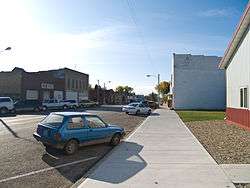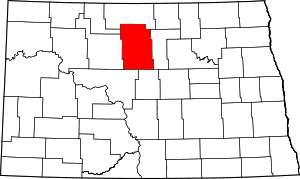Anamoose, North Dakota
Anamoose is a city in McHenry County, North Dakota, United States. The population was 227 at the 2010 census.[5] It is part of the Minot Micropolitan Statistical Area.
Anamoose, North Dakota | |
|---|---|
 Business district of Anamoose | |
 Location of Anamoose, North Dakota | |
| Coordinates: 47°52′52″N 100°14′31″W | |
| Country | United States |
| State | North Dakota |
| County | McHenry |
| Area | |
| • Total | 0.63 sq mi (1.64 km2) |
| • Land | 0.62 sq mi (1.61 km2) |
| • Water | 0.01 sq mi (0.02 km2) |
| Elevation | 1,621 ft (494 m) |
| Population | |
| • Total | 227 |
| • Estimate (2019)[3] | 244 |
| • Density | 391.65/sq mi (151.18/km2) |
| Time zone | UTC-6 (Central (CST)) |
| • Summer (DST) | UTC-5 (CDT) |
| ZIP code | 58710 |
| Area code(s) | 701 |
| FIPS code | 38-02220 |
| GNIS feature ID | 1027700[4] |
| Website | Anamoose.com |
Anamoose was established along the main line of the Soo Line Railroad in 1898 by Romanians who had come from Saskatchewan, Canada. The name is a corruption of the Chippewa word uhnemoosh, which means "female dog."[6]
Geography
Anamoose is located at 47°52′52″N 100°14′31″W (47.881153, -100.241860).[7]
According to the United States Census Bureau, the city has a total area of 0.62 square miles (1.61 km2), of which 0.61 square miles (1.58 km2) is land and 0.01 square miles (0.03 km2) is water.[8]
Demographics
| Historical population | |||
|---|---|---|---|
| Census | Pop. | %± | |
| 1910 | 669 | — | |
| 1920 | 563 | −15.8% | |
| 1930 | 495 | −12.1% | |
| 1940 | 478 | −3.4% | |
| 1950 | 542 | 13.4% | |
| 1960 | 503 | −7.2% | |
| 1970 | 401 | −20.3% | |
| 1980 | 355 | −11.5% | |
| 1990 | 277 | −22.0% | |
| 2000 | 282 | 1.8% | |
| 2010 | 227 | −19.5% | |
| Est. 2019 | 244 | [3] | 7.5% |
| U.S. Decennial Census[9] 2018 Estimate[10] | |||
2010 census
As of the census[2] of 2010, there were 227 people, 108 households, and 72 families residing in the city. The population density was 372.1 inhabitants per square mile (143.7/km2). There were 140 housing units at an average density of 229.5 per square mile (88.6/km2). The racial makeup of the city was 99.6% White and 0.4% Native American.
There were 108 households, of which 19.4% had children under the age of 18 living with them, 58.3% were married couples living together, 5.6% had a female householder with no husband present, 2.8% had a male householder with no wife present, and 33.3% were non-families. 32.4% of all households were made up of individuals, and 18.5% had someone living alone who was 65 years of age or older. The average household size was 2.10 and the average family size was 2.61.
The median age in the city was 48.6 years. 18.5% of residents were under the age of 18; 6.6% were between the ages of 18 and 24; 19.8% were from 25 to 44; 25.1% were from 45 to 64; and 30% were 65 years of age or older. The gender makeup of the city was 50.7% male and 49.3% female.
2000 census
As of the census of 2000, there were 282 people, 130 households, and 86 families residing in the city. The population density was 455.2 people per square mile (175.6/km2). There were 149 housing units at an average density of 240.5 per square mile (92.8/km2). The racial makeup of the city was 99.65% White, and 0.35% from two or more races. 0.00% of the population were Hispanic or Latino of any race.
The top 6 ancestry groups in the city are German (66.0%), Norwegian (19.1%), English (5.7%), Swedish (4.3%), Czech (3.9%), United States (3.9%).
There were 130 households, out of which 21.5% had children under the age of 18 living with them, 56.9% were married couples living together, 5.4% had a female householder with no husband present, and 33.8% were non-families. 31.5% of all households were made up of individuals, and 22.3% had someone living alone who was 65 years of age or older. The average household size was 2.17 and the average family size was 2.73.
In the city, the population was spread out, with 19.9% under the age of 18, 5.3% from 18 to 24, 21.6% from 25 to 44, 21.3% from 45 to 64, and 31.9% who were 65 years of age or older. The median age was 47 years. For every 100 females, there were 94.5 males. For every 100 females age 18 and over, there were 96.5 males.
The median income for a household in the city was $28,438, and the median income for a family was $40,192. Males had a median income of $28,750 versus $19,688 for females. The per capita income for the city was $15,120. About 5.1% of families and 12.7% of the population were below the poverty line, including 11.9% of those under the age of eighteen and 22.8% of those 65 or over.
References
- "2019 U.S. Gazetteer Files". United States Census Bureau. Retrieved July 27, 2020.
- "U.S. Census website". United States Census Bureau. Retrieved June 14, 2012.
- "Population and Housing Unit Estimates". United States Census Bureau. May 24, 2020. Retrieved May 27, 2020.
- "US Board on Geographic Names". United States Geological Survey. October 25, 2007. Retrieved January 31, 2008.
- "2010 Census Redistricting Data (Public Law 94-171) Summary File". American FactFinder. United States Census Bureau. Retrieved May 2, 2011.
- Wick, Douglas A. "Anamoose (McHenry County)". North Dakota Place Names. Retrieved May 5, 2011.
- "US Gazetteer files: 2010, 2000, and 1990". United States Census Bureau. February 12, 2011. Retrieved April 23, 2011.
- "US Gazetteer files 2010". United States Census Bureau. Archived from the original on January 12, 2012. Retrieved June 14, 2012.
- United States Census Bureau. "Census of Population and Housing". Retrieved October 30, 2013.
- "Population Estimates". United States Census Bureau. Retrieved June 22, 2019.
